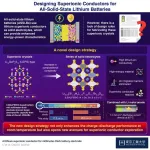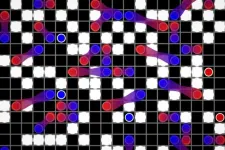(Press-News.org) Hand tremors and slowed movements are two of the most widely recognized hallmarks of Parkinson’s disease, and for many sufferers the first indication that something is amiss. But by the time these symptoms manifest, those patients have already lost 50–80 percent of their dopamine neurons—a mass die-off that causes the neurodegenerative disease. Malfunctions in dopamine-dependent areas of the brain are responsible for many of the symptoms, which differ from person to person in an unpredictable way.
A diagnosis at an early age, typically before age 50, can stave off the most severe symptoms for years; when the disease is identified later, its trajectory is often swift and severe—but in lieu of symptoms, doctors have no tools for predicting the disease course.
Now scientists at Rockefeller University have made multiple discoveries that open new paths for the early prediction of disease trajectories and treatment of Parkinson’s. As published in Nature Communications, they found distinct RNA changes both in the blood of living Parkinson’s patients and in the brains of deceased Parkinson’s patients—and identified that there are many overlapping changes. These changes were further associated with many of the clinical symptoms of the disease.
The ability to detect molecular changes in the blood that mirror the changes in the brain could potentially be used to develop biomarkers that could predict a patient’s disease trajectory, allowing doctors to tailor treatment to the stage and symptoms of their disease, says first author Krithi Irmady, a movement disorders physician in the Laboratory of Molecular Neuro-oncology, headed by Robert B. Darnell. “We also think the molecular pathways we identified have great potential for pharmacological manipulation,” she says.
When dopamine neurons die
The second most common neurodegenerative disease after Alzheimer’s in the world, Parkinson’s is caused by the death of dopamine neurons in the substantia nigra, an area of the midbrain. Though often associated with feelings of pleasure, the neurotransmitter dopamine also helps to regulate motivation, memory, cognition, and movement.
One dopamine-dependent area connected to these essential functions is the striatum, located just above the substantia nigra. The striatum has two regions: the caudate and the putamen. Both are richly stocked with identical neurons, but they behave differently when it comes to Parkinson’s. When the caudate is starved of dopamine, cognitive impairment follows. When the putamen is, motor control goes off the rails. It’s a slow adaptive process, and the molecular reasons for these different responses have not been established in human brains.
Brain changes
In the first part of the study, the researchers sequenced RNA from the caudate and putamen of 35 people who’d died with Parkinson’s disease and compared those to 40 brains of neurologically normal brains as a control. They also delved into the clinical histories of those who’d had Parkinson’s to learn what their symptoms were and at what age they’d been diagnosed.
The Parkinson’s brains were brimming with RNA-driven changes in gene expression. And for the first time, researchers were able to link distinctly different molecular patterns in the striatum with patient symptoms.
“Patients with dementia had particular molecular patterns that were associated with the caudate,” Irmady says, including signaling mechanisms related to DNA packaging, which controls gene expression, and indicators of cellular stress.
In patients with involuntary jerky movements known as levodopa-induced dyskinesia—a known side-effect of levodopa, the main Parkinson’s medication—they found that the putamen’s endothelial cells, which form the lining of blood vessels, underwent molecular changes suggestive of self-destruction and vascular permeability, causing a kind of “leakiness.”
“It’s possible that when these blood vessels are affected differently in these patients, they have more access to the drug itself, causing too much medication in their brains,” Irmady says.
The caudate and putamen also showed distinct changes the longer someone had the disease. In the caudate, they found changes in the growth of the cells that form protective sheaths around brain nerves, while in the putamen they found distinctly different molecular changes suggestive of senescence, or accelerated aging of the cells. Because drugs that slow down cellular aging in Alzheimer’s patients are currently in clinical trials, “it was interesting for us to see that these pathways were affected in the putamen in Parkinson’s,” Irmady says. If the drugs prove effective for Alzheimer’s, perhaps a similar therapeutic approach could be taken for Parkinson’s.
There was also a marked difference between the brains of people who’d been diagnosed with Parkinson’s before age 55 and those who’d been diagnosed after. “The younger-onset patients had very modest changes of RNA compared to the controls, whereas the later-onset patients had thousands of genes that had changed,” Irmady says.
The findings, she says, “give molecular validation to what we sort of knew clinically: these patients are different. Now we know that their brains look different too.”
Blood ties
In the second part of the study, the team studied RNA from blood samples collected from 479 people in the Parkinson’s Progression Markers Initiative databank and compared them with 195 controls.
“We wanted to see what the overlap was between the brain and the blood,” Irmady says.
They found that hundreds of RNAs were significantly up- or downregulated in the blood of people with Parkinson’s—and remarkably, these RNA changes were altered in the same way in the caudate and the putamen. Many RNAs that would be expected to have a role in brain nerve-cell functions were in fact the most-altered RNAs detected in the blood. These nerve cell function–related RNAs also changed more in the blood with worsening disease severity. Similarly, RNAs associated with dementia in the caudate were also changed in the same direction in the blood of living patients with cognitive problems.
The researchers also found that the blood differed between those who had a younger onset versus a later onset of the disease. Just as the brains of later onset people with Parkinson’s disease showed more RNA changes, so too did the blood of living Parkinson’s patients.
Though they were “excited to notice this concordance between the blood and the brain,” Irmady says, “we don’t actually know why it happens. Are some of the RNAs from the brain just reflected in the blood, or is Parkinson’s a multisystem disease that has common patterns of gene expression across different systems of the body?”
Though such questions remain, Irmady has high hopes for the possibilities that could develop from their discoveries, including tools for predicting the course of the disease and new treatment avenues. “I think our findings will generate excitement about the promise of blood-focused studies for Parkinson’s disease,” she says.
END
Researchers discover potential molecular indicators for Parkinson’s symptoms
2023-07-06
ELSE PRESS RELEASES FROM THIS DATE:
Study supports “catch up” HPV test in older women
2023-07-06
For women over the age of 65 who have never had a high-risk human papillomavirus (HPV) test, a “catch up” HPV screening intervention may improve cervical cancer prevention by detecting more cervical pre-cancer lesions as compared to women not offered screening. That is the conclusion of a new study publishing July 6th in the open access journal PLOS Medicine by Mette Tranberg, University Research Clinic for Cancer Screening, Randers Regional Hospital, Denmark, and colleagues.
High-risk human papillomavirus (HPV) test is replacing cytology as the primary cervical cancer screening test in most countries, but many women over 65 years have never had an HPV ...
The solstice switch: Warming’s effects on autumn leaf senescence depend on timing
2023-07-06
How temperate and boreal trees’ leaves respond to climate change remains uncertain. Now, a new study of northern forests reports that while early-season climate warming – that occurring before the summer solstice – tends to be associated with earlier autumn leaf senescence, late-season warming (after the summer solstice) has the opposite impact, delaying onset of leaf senescence in fall. “Improved models of plant development and growth under climate change will need to incorporate the reversal of warming effects after the summer solstice,” write Constantin Zohner and colleagues, authors of the study. Climate change ...
Two studies report: Perovskite-silicon tandem cells that break the 30% efficiency threshold
2023-07-06
In two separate studies, researchers present novel methods that enable the fabrication of high-performance perovskite-silicon tandem solar cells with power conversion efficiencies exceeding 30%. Silicon solar cells – the most commonly deployed photovoltaic (PV) technology – are rapidly approaching their theoretical power conversion efficiency (PCE) limit of 29%. One way to increase the efficiency of a solar cell is to optimize the spectrum of sunlight for conversion into energy. This can be done by stacking two or more interconnected photoactive materials into a singular device, improving ...
Precipitation tolerance helped explain which vertebrate species spread between newly joined continents
2023-07-06
A new study helps explain why rates of species exchange are at least twice as high from west to east than in the opposite direction across Wallace’s Line. The study included an analysis of more than 20,000 species belonging to all 227 families of terrestrial vertebrates present in the Indo-Australian archipelago. As tectonic plates merge, once disparate continents can connect and create new opportunities for biotic exchange. Species movement across newly connected continents millions of years ago continues to shape assemblages of flora and fauna today. One of the most well-known ...
Ready for its close-up: The electron’s permanent electric dipole moment
2023-07-06
A new study with direct implications for one of the most important unresolved questions in physics – the imbalance of matter and antimatter in our universe – reports “the most precise measurement yet” of the size of the electron’s permanent electric dipole moment. The imbalance between matter and antimatter in the Universe can be explained via the breaking of charge parity symmetry. The standard model (SM) of particle physics predicts a slight breaking of this symmetry, but it is insufficient to explain the imbalance actually observed. Many extensions to the standard ...
Policymakers should consider animal welfare in decisions
2023-07-06
Incorporating animal welfare into policymaking may improve policy and practice, according to Rutgers research.
The article, published in Science, notes that animal welfare rarely is considered during policymaking, explains why current tools make it difficult to incorporate the well-being of animals into public policy and identifies methods for remedying these issues.
“Animal welfare is often ignored in policymaking, despite its relevance across many domains ranging from food systems to biomedical research to climate policy,” said Mark ...
Why you won’t see kangaroos in Java but you will find goannas in Australia
2023-07-06
Ask anyone what first springs to mind when they think of Australia and they’ll most likely say a kangaroo; the marsupial is ingrained in our national identity. But have you ever wondered why kangaroos never ventured beyond our shores?
A major study led by biologists at The Australian National University (ANU) and ETH Zurich in Switzerland provides a new explanation for why you won’t find kangaroos, koalas and other Aussie marsupials in Indonesia, but you will find many groups of animals that originated in Asia, such as goannas, ...
New design rule for high-entropy superionic solid-state conductors
2023-07-06
Solid electrolytes with high lithium-ion conductivity can be designed for millimeter-thick battery electrodes by increasing the complexity of their composite superionic crystals, report researchers from Tokyo Tech. This new design rule enables the synthesis of high-entropy active materials while preserving their superionic conduction.
As the world transitions towards a greener and more sustainable energy economy, reliance on lithium (Li)-ion batteries is expected to rise. Scientists from across the globe are working towards designing smaller yet efficient batteries that can keep up with the ever-increasing demand for energy ...
Why there are no kangaroos in Bali (and no tigers in Australia)
2023-07-06
If you travel to Bali, you won’t see a cockatoo, but if you go to the neighbouring island of Lombok, you will. The situation is similar with marsupials: Australia is home to numerous marsupial species, such as the kangaroo and the koala. The further west you go, the sparser they become. While you will find just two representatives of these typically Australian mammals on the Indonesian island of Sulawesi, you will search in vain for them on neighbouring Borneo. Australia, on the other hand, is not home to mammals that you will typically find in Asia, such as bears, tigers ...
MIT physicists generate the first snapshots of fermion pairs
2023-07-06
CAMBRIDGE, Mass. -- When your laptop or smartphone heats up, it’s due to energy that’s lost in translation. The same goes for power lines that transmit electricity between cities. In fact, around 10 percent of the generated energy is lost in the transmission of electricity. That’s because the electrons that carry electric charge do so as free agents, bumping and grazing against other electrons as they move collectively through power cords and transmission lines. All this jostling generates friction, and, ultimately, heat.
But when electrons pair up, they can rise above the fray and glide through a material without ...




